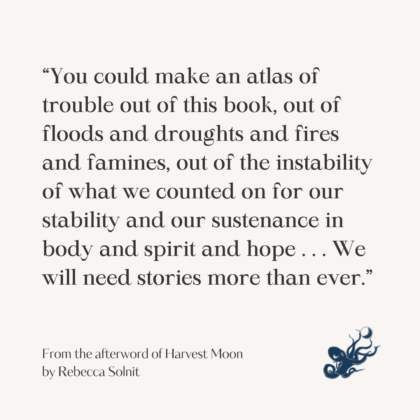Diverse voices on climate change
A FEW months before the Taal volcano eruption and the start of the coronavirus disease 2019 (COVID-19) pandemic in 2020, a team of writers from around the world met to brainstorm about writing a book on climate change. Filipino anthropologist and writer Padmapani L. Perez, South African novelist and journalist Rehana Rossouw, Colombian poet and performer Alexandra Walter, and Filipino author Renato Redentor Constantino looked through images submitted by photographers from various countries. After selecting 30 photographs, their next step was to send these to writers in their respective regions to serve as inspiration.
The result was Harvest Moon: Poems and Stories from the Edge of the Climate Crisis, an anthology on climate change.
The book is a project of the Institute for Climate and Sustainable Cities’ The Agam Agenda, a platform that brings together writers, artists, scientists, youth, and campaigners for creative, transdisciplinary collaboration for climate action through stories and art.
The book contains over 30 images and over 30 poems, stories, and essays by writers, photographers, and artists from Africa, Asia, the Pacific, and Latin America. The contributions come from 24 countries and are written in 11 languages, including Turkish, Spanish, Kankanaey, French, Filipino, English, Chinese, and Bahasa Indonesia.
“The making of this book followed a creative process that we first tried out in Agam Filipino Narratives on Uncertainty and Climate Change (2014). We invited photographers in Africa, Asia, the Pacific, and Latin America to send in black and white images that showed a place or space with people or traces of humanity in them. Out of over 80 submissions, we selected 30 plus of the best photographs,” Ms. Perez, Agam Agenda lead strategist and the book’s co-editor, said at the online book launch on Feb. 18.
In the selection of photographs, Ms. Perez added that the co-editors “veered away from typical imagery of the environment and disasters.” Every contributing writer received a randomly selected photograph. The writers were tasked to respond to photographs from outside their respective regions.
Ms. Perez further explained that the writers also received a list of 32 words and phrases that they were not allowed to use in their pieces, such as “climate change” and “global warming.” “The intention was to discourage the use of jargon and to steer away from tired ways of describing the state we’re in,” she said.
Contributors include internationally recognized writers Shirley Campbell Barr (Costa Rica), Marjorie Evasco (Philippines), Luisa A. Igloria (Philippines/USA), Kathy Jetñil-Kijiner (Marshall Islands), Fiston Mwanza Mujila (Democratic Republic of Congo), Leonardo Padura (Cuba), Malebo Sephodi (South Africa), photographer Vinai Dithajohn (Thailand), and renowned essayist Rebecca Solnit.
Filipino contributing writer Gawani Domogo Gaongen interprets a photo by South African photographer Masixole Feni showing a young goalkeeper in a soccer field. The resulting Kankanaey poem “Pangwani” (which also includes an English translation by the author) illustrates how moments on earth and the distance of places are measurements of time.
Since the project was interrupted in 2020, the book also includes poems and stories related to the COVID-19 pandemic.
One of the Filipino contributing writers, Joey A. Tabula, a physician by profession, wrote the poem “Awit sa Dibdib ng Mamang may COVID (Song in the Chest of a Man with COVID).” He interpreted Vinai Dithajohn’s photograph of a half-naked man taking a bath in a lake.
“I was sent a number of images and then it was really hard to choose because all the images are rich [with] interpretation. But I chose the one that spoke to me,” Mr. Tabula said of the photo. “The loneness of the person and taking a bath kind of reminds me of patients in [ICU] getting the morning care of nurses and nursing assistants.”
He wrote the poem in the persona of a physician taking care of a patient.
Pieces from Harvest Moon were also featured in artistic collaborations to coincide with the 26th UN Climate Change Conference (COP26) international negotiations in Nov. 2021. Works were featured in light projections by artist Jenny Holzer throughout the city center of Glasgow, Scotland, and at the Tate Modern in London.
“Through Harvest Moon, we hope to show that art and literature have a role to play, not just in communicating climate change, but also in accompany us through the crisis, providing solace, companionship, and opening portals to new possibilities,” Ms. Perez said.
Harvest Moon (P599.60) is now available via Milflores Publishing on Shopee and Lazada, Fully Booked, the Ayala Museum Shop, Mt. Cloud Bookshop in Baguio City, and Solidaridad Bookstore in Manila. To order the book, visit http://agamagenda.com/harvest-moon. — Michelle Anne P. Soliman






